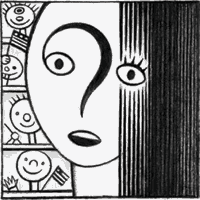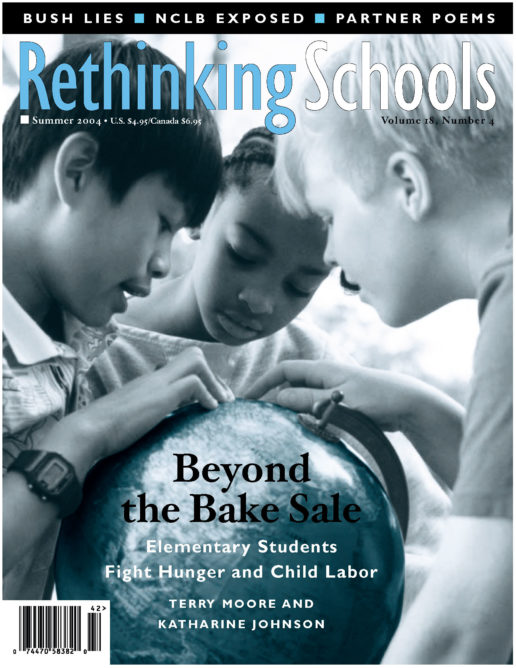Editorial: Teaching Against the Lies
Illustrator: Gale

In the 1974 Academy Award-winning documentary Hearts and Minds, Daniel Ellsberg comments on how U.S. involvement in Vietnam was sold to Americans:
Truman lied… Eisenhower lied… Kennedy lied… Johnson lied and lied and lied… Nixon lied… The American public was lied to month by month by each of these five administrations. As I say, it’s a tribute to the American public that their leaders perceived that they had to be lied to. It’s no tribute that it was so easy to fool the public.
The Vietnam-era administrations’ packaging of war and the Bush administration’s sale of a war agenda to the American public are hauntingly similar. Once again, the United States is engaged in a war thousands of miles from home. Once again, we’re told that the war is necessary to bring freedom and democracy. Once again, people are killing and being killed. And once again, Americans have been lied to-in this instance, about weapons of mass destruction, Saddam Hussein’s link to al-Qaida, the U.S. government’s altruistic framing of war as part of a larger concern for democracy, the glib contempt for Iraqi opposition.
As the horrifying photos and reports of U.S. military personnel abusing Iraqis at Abu Ghraib prison have made their way into the public eye, a clearer picture of the occupation is emerging. Even before the scandal broke on “60 Minutes II” in late April, Amnesty International warned that U.S.-led forces have “shot Iraqis dead during demonstrations, tortured and ill-treated prisoners, arrested people arbitrarily and held them indefinitely, demolished houses in acts of revenge and collective punishment.”
Furthermore, Iraq’s resources and industries are being sold to the highest bidders-what Naomi Klein describes in The Nation as “privatization without representation.”
The question before educators is whether or not we are equipping students with the tools to think critically about our government’s policies. Will today’s U.S. leaders discover that it is “so easy to fool the public”? If so, some of the responsibility will lie with what is or is not going on in schools.
It’s not mere hyperbole to suggest that critical teaching today is a matter of life and death. April 2004 was the deadliest month for U.S. troops since October 1971. Some of our former students are coming home maimed or in body bags, while the military continues to step up recruiting. And the Associated Press estimates that more than ten Iraqis have been killed for every American lost-more than 1300 people in one month alone.
Identifying arguments, sorting through conflicting sources of information, and “talking back” to the world are cornerstones of the critical teaching we advocate in our introduction to Rethinking Our Classrooms, Vol. 1, “Creating Classrooms for Equity and Social Justice”:
Students must learn to pose essential critical questions: Who makes decisions and who is left out? Who benefits and who suffers? Why is a given practice fair or unfair? What are its origins? What alternatives can we imagine? What is required to create change?
While these principles operate differently in elementary, middle school, or high school classrooms, they can be useful at any grade level to guide curriculum decisions in a time of war. Providing opportunities for students to generate, pose, and seek answers to questions like these can provide students with the intellectual tools they need to decipher the high-sounding packaging of war and exploitation.
No matter what we teach, our curriculum should help students reflect critically on the world around them, including our government’s actions. For example, in a U.S. history course, a critical approach to relations between white settlers and Native Americans should evaluate the “friendly Indian/unfriendly Indian” dichotomy. In traditional histories, especially in many children’s books, “good” Indians welcome newcomers but “bad” Indians attack the innocent, well-meaning settlers. A critical examination of long-ago history can help students see the colonial bias in similar constructions about the war in Iraq. One of U.S. Administrator Paul Bremer’s deputies recently talked about the “good Iraqis” in Fallujah, who did not resist U.S. forces, and the “bad Iraqis,” who attacked the Marines attempting to “pacify” the town. This framing of Iraqi behavior begins from the premise that “we” are the good guys, who seek nothing but freedom and tranquility-a formulation that has been used countless times in history texts to mask U.S. imperialism.
We’re not suggesting that teachers drop what they’re teaching and begin to study the war in Iraq-although for some this might be a fine choice. Without abandoning the regular curriculum, a critical, social justice teacher can pause to ask her students, “Given what we’ve learned this year, what questions should we be asking about the war in Iraq?” A fine model of this teaching strategy can be found in S. J. Childs’ Rethinking Schools article “Questions are the Answer” [Vol. 15, No. 4].
A critical literacy consistently gives students permission and encouragement to question received wisdom-whether from textbooks or presidents. It develops habits of skepticism. And it also makes this approach explicit to students, helping them recognize how a critical perspective on the world differs from what they might encounter in their textbooks or on the nightly news.
Our curriculum ought to help prevent students from becoming the gullible propaganda victims that Daniel Ellsberg describes. But it’s important that a critical curriculum does not itself become propaganda, simply offering conclusions and handing students anti-war positions. Our aim is not to get students to parrot our ideas, but to equip them with the thinking skills they will need for a life of democratic participation, of active citizenship.
In the long run it’s this kind of teaching that will contribute to building the social movements that can combat militarism. This is the teaching that Rethinking Schools invites readers to practice.

